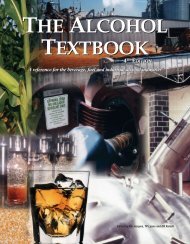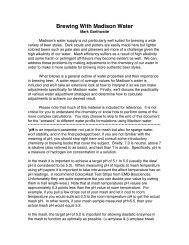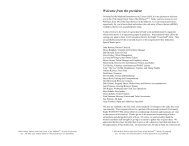The Compleat Distiller
The Compleat Distiller
The Compleat Distiller
Create successful ePaper yourself
Turn your PDF publications into a flip-book with our unique Google optimized e-Paper software.
THE COMPLEAT DISTILLER 65<br />
Stage 3<br />
From this point on, an almost pure azeotropic mix of ethanol and water will be coming through and<br />
may be collected as the main product. <strong>The</strong> temperature should remain absolutely stable throughout the<br />
collection of the main product, and you can increase the rate of collection to around 4 drops per second.<br />
We give guidelines in terms of drops per second, but the size of a drop is affected by many things – its<br />
composition, its temperature, and the size of the tube it is dripping from. <strong>The</strong> real measure is the<br />
production rate, remembering that we want to collect the main body of ethanol at 90% reflux. 750<br />
Watts will produce about 50 ml of 95% ethanol per minute, so you want to be collecting between 4 and<br />
5 ml per minute to establish a reflux ratio of 90%.<br />
<strong>The</strong> best way to measure this is to establish a slow flow, begin collecting it in a small graduated<br />
cylinder, and measure the time it takes to collect 10 ml. Keep adjusting the valve until it takes two to<br />
two and a half minutes. When you are satisfied with the collection rate, count the number of drops you<br />
get in 10 seconds. Do this three or four times, and take the average.<br />
In the future, you can reset the still to the same 90% reflux ratio by adjusting the valve until you have<br />
the correct number of drops falling in 10 seconds. This adjustment may be made quite rapidly.<br />
In our experience, the correct rate of collection is found at about 35 drops in 10 seconds – not far off<br />
the 4 drops we recommended above! For the best accuracy, though, you should make this<br />
measurement yourself and calibrate your system.<br />
Calculating on the basis that the 20 liters put in the boiler contains 8 liters of ethanol, it will take<br />
around 14 hours to collect all of it. You could get slightly better purity if you reduced the draw-off rate<br />
to 2 drops a second, but the run would take twice as long.<br />
To achieve the highest purity, you will take the slow road, and you probably won’t want to watch the<br />
still for 16-18 hours, not to mention the extra attention required near the end, checking for the onset of<br />
tails. Fortunately, all the toxic compounds and heads have been removed, so it's perfectly safe to stop<br />
the run at any time and resume it later. You will have to equilibrate the column again, but since the<br />
most volatile component is now ethanol, it will only take an hour at 100% reflux. Once equilibrium is<br />
achieved, you can start collecting product immediately.<br />
Stage 4<br />
Since you know how much ethanol was in the boiler, and you know the rate of collection, you can<br />
calculate when the end of the run should be. About an hour before this time, you should start collecting<br />
in small bottles and checking them for taste and smell before adding them to the main container. Your<br />
sense of smell is much more sensitive than the thermometer.<br />
When you detect tails in the product, switch to a tails container. You can raise the collection rate now,<br />
and continue until the temperature has risen a few degrees, indicating that all the ethanol has been<br />
collected. You can add the collected tails to the boiler of the next batch along with the heads.<br />
Stage 5<br />
<strong>The</strong> product from a compound still is often much purer than commercially produced vodka, and most<br />
people are very satisfied with it as it comes from the still. If you want the ultimate in purity, process<br />
the product with activated carbon to remove the last hint of any congeners. We especially recommend<br />
carbon treatment if you are planning on making perfumes, essences, or delicately flavored liqueurs. It<br />
shouldn’t be necessary if you want to make strongly flavored beverages or mixed drinks. <strong>The</strong> final<br />
choice, of course, is up to you, and you should have some fun experimenting with these options. Let<br />
your own taste and preference be your guide.









